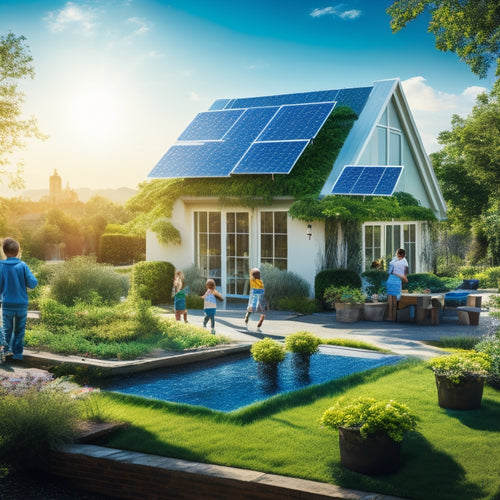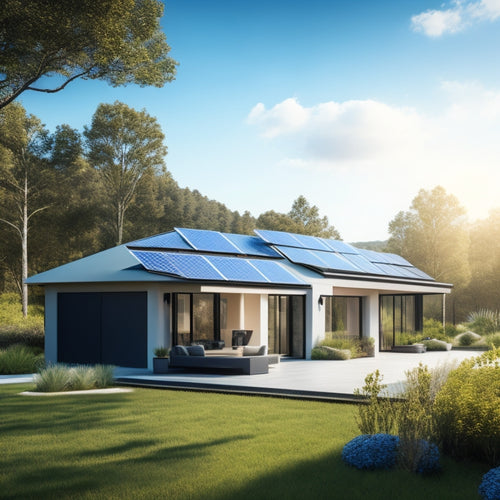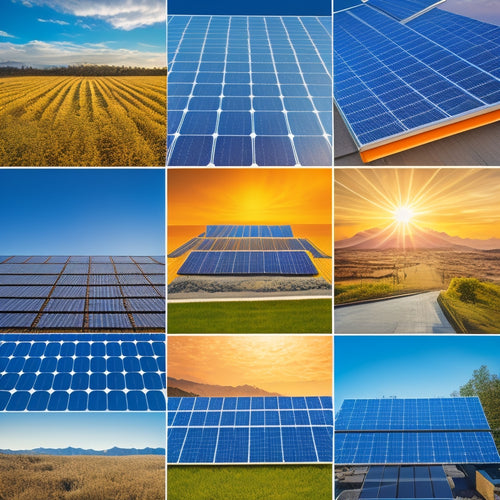
How to Implement Solar Energy for Residential Homes
Share
You're ready to utilize the power of the sun to cut your energy bills and contribute to a sustainable future. First, assess your home's solar potential by evaluating its orientation, roof size, and local building codes. Then, choose the right solar panels based on efficiency, warranty, and aesthetic preferences. Select a system size that meets your energy needs and budget, considering factors like inverters and mounting systems. Guarantee a safe connection to the grid, and take advantage of federal and state incentives, as well as local rebate programs. As you steer through the process, you'll uncover the key details necessary to make an informed decision.
Key Takeaways
- Assess your home's solar potential by evaluating roof size, local building codes, and shading obstacles to determine optimal panel placement.
- Choose the right solar panels by considering efficiency ratings, warranty, and aesthetic options to ensure a reliable and high-performing system.
- Select a solar energy system that meets your energy needs, budget, and local regulations, and consider energy efficiency options like inverters and mounting systems.
- Ensure a safe and compliant installation by obtaining necessary permits, conducting site assessments, and connecting to the grid through a licensed electrician.
- Take advantage of incentives and rebate programs, including federal tax credits, state incentives, and local programs to maximize your return on investment.
Understanding Solar Energy Basics
Utilizing solar energy for your home begins with grasping the fundamentals of this renewable power source. You need to understand that solar energy is a broad term that encompasses various types of energy capturing technologies.
There are two primary solar energy types: thermal energy and electric energy. Thermal energy is used for heating water or spaces, whereas electric energy is generated through photovoltaic (PV) technology.
Photovoltaic technology is the most common method of generating solar energy for homes. It involves converting sunlight into electricity using solar panels composed of semiconducting materials. When sunlight hits these materials, it excites the electrons, which then flow through the material to create an electric current.
This current is then channeled through an inverter, converting it into usable alternating current (AC) electricity for your home.
As you consider implementing solar energy, it's vital to recognize the role of photovoltaic technology in capturing this renewable resource. By understanding the basics of solar energy, you'll be better equipped to make informed decisions about integrating this clean power source into your home.
Assessing Your Home's Solar Potential
Now that you've got a handle on the basics of solar energy, it's time to evaluate your home's potential for utilizing this renewable resource. Conducting a solar site analysis is vital to determine the feasibility of installing solar panels on your property.
This analysis involves evaluating your home's orientation, roof size, and local building codes to guarantee compliance with solar panel installation regulations.
A shading assessment is also fundamental to identify any obstacles that may hinder sunlight from reaching your solar panels. This includes examining the presence of trees, buildings, and other structures that may cast a shadow on your roof.
By doing so, you can determine the best placement and angle of your solar panels to maximize energy production.
During the evaluation, you'll also need to reflect on local climate conditions, such as average sunlight hours and temperature, to determine the most suitable solar panel system for your location.
Choosing the Right Solar Panels
With numerous solar panel options available, selecting the right ones for your home can be an intimidating task.
You'll need to take into account various factors to guarantee you get the most out of your solar energy system. First, you'll want to investigate different solar panel types, such as monocrystalline, polycrystalline, and thin-film panels, each with its own efficiency ratings and benefits.
Efficiency ratings, ranging from 15% to 22%, will impact how much energy your system produces.
Warranty considerations are also important, as they can vary from 10 to 30 years or more. You'll want to weigh installation costs against the long-term benefits of your chosen panels.
Aesthetic options, like black or silver frames, can also influence your decision. Brand comparisons will help you identify reliable manufacturers with a track record of providing high-quality products.
Additionally, take into account the environmental impact of your chosen panels, as well as technology advancements that may improve performance over time.
Selecting a Solar Energy System
When selecting a solar energy system for your home, you'll need to contemplate the size of the system, which will depend on your energy needs and available roof space.
You'll also want to investigate energy efficiency options, such as inverters and mounting systems, to maximize your system's performance.
System Size Considerations
Determining the ideal system size for your solar energy installation is essential to ensuring you generate enough power to meet your energy needs while also avoiding overspending on unnecessary capacity.
You'll want to strike a balance between generating enough electricity and not oversizing your system, which can lead to higher upfront costs.
To determine the right system size for your home, consider the following factors:
-
Energy demand: Calculate your energy usage by reviewing your past utility bills or conducting an energy audit to determine how much electricity you need to generate.
-
Roof size and orientation: Assess the amount of available roof space and its orientation to determine how many solar panels can be installed.
-
Local building codes and regulations: Familiarize yourself with local building codes, permits, and regulations that may impact system size.
-
Shading and obstruction: Take into account any shading or obstructions that may affect the system's performance, such as trees, chimneys, or skylights.
-
Budget and financing: Determine how much you're willing to invest in your solar energy system and investigate financing options that may impact system size.
Energy Efficiency Options
Now that you've determined the ideal system size for your solar energy installation, it's time to investigate energy efficiency options for selecting a solar energy system that meets your needs.
Energy efficiency plays an essential role in maximizing the benefits of your solar energy system. By reducing your energy consumption, you can optimize the performance of your solar panels and reduce your reliance on the grid.
One effective way to achieve this is by investing in energy-efficient appliances. These appliances consume less power, reducing the load on your solar energy system and allowing you to generate more electricity.
Additionally, consider improving your home insulation to minimize heat loss and reduce the need for heating and cooling. This not only saves energy but also extends the lifespan of your solar panels by reducing the strain on your system.
Installation and Setup Process
Your solar panel system's installation and setup process begins with a thorough assessment of your home's energy requirements and solar potential. This involves evaluating your roof's size, orientation, and type to determine the best placement of your solar panels.
You'll also need to obtain installation permits from your local government, which may require inspections and approvals.
Here are the key steps involved in the installation and setup process:
- Conducting a site assessment to identify potential shading issues and structural integrity of your roof
- Designing a customized solar panel system to meet your energy needs and budget
- Installing the solar panels on your roof, considering different roof types and their unique requirements
- Connecting the solar panels to an inverter, which converts DC power to AC power for your home
- Installing a net meter to track your energy production and consumption, and connecting to the grid
Incentives and Rebate Programs
With your solar panel system installed and set up, you're ready to reap the benefits of utilizing renewable energy.
Now, it's time to investigate the incentives and rebate programs available to you. The federal government offers tax credits that can greatly reduce your tax liability. Additionally, your state may provide incentives such as rebates, grants, or property tax exemptions.
Local governments and utilities may also offer rebates, financing options, or special utility programs. You can take advantage of solar loans with favorable terms or energy credits that can be sold or traded.
Some states even offer installation grants or community solar programs that allow you to participate in a shared solar array. Be sure to research and take advantage of these incentives to maximize your return on investment.
Connecting to the Grid Safely
When connecting your solar panel system to the grid, you'll need to guarantee it's done safely to avoid electrical shock, fire, or other hazards.
A key component in achieving grid connection safety is the grid tie inverter, which synchronizes your system's output with the grid's frequency and voltage.
Grid Connection Safety
About 80% of solar energy systems installed in the United States are grid-tied, meaning they're connected to the electrical grid and allow homeowners to sell excess energy back to the utility company.
As you consider connecting your solar energy system to the grid, safety should be your top priority. You must guarantee that your system meets all relevant safety regulations and electrical standards.
When connecting to the grid, you should:
- Verify your system is installed and certified by a licensed electrician
- Comply with National Electric Code (NEC) and Underwriters Laboratories (UL) standards
- Install a grid-tie inverter that meets IEEE 1547 standards
- Use correctly sized and rated electrical components to prevent overheating and electrical shock
- Regularly inspect and maintain your system to prevent electrical faults and guarantee safe operation
Grid Tie Inverters
One essential component of a grid-tied solar energy system is the grid tie inverter, which converts the DC power generated by your solar panels into AC power that's synchronized with the grid's frequency and voltage. This guarantees safe and efficient energy transmission to your home.
As you connect to the grid, the inverter's primary function is to synchronize your solar power output with the grid's voltage and frequency, allowing you to sell excess energy back to the utility company.
When selecting a grid tie inverter, consider factors like maximum power point tracking (MPPT), efficiency, and compatibility with your solar panel array. You'll also want to verify the inverter meets local safety and regulatory standards.
If you're considering off-grid systems or hybrid solutions, you may need to choose an inverter that can handle both grid-tied and off-grid modes. Be sure to research and compare different models to find the one that best suits your energy needs and budget.
Monitoring and Maintenance Tips
Regularly monitoring your solar panel system's performance is crucial to guaranteeing you maximize your energy savings and identify potential issues early on.
You'll want to keep a close eye on your system's performance to make sure it's operating at its best level.
To do this, you'll need to perform routine maintenance tasks, including:
- Checking your system's energy output regularly to identify any dips in performance
- Inspecting your panels for dirt, debris, and damage that could impact energy production
- Verifying that your system's inverters are functioning correctly and efficiently
- Performing system troubleshooting to identify and address any technical issues
- Reviewing your system's performance monitoring data to identify trends and areas for improvement
Overcoming Common Obstacles
Overcoming Common Obstacles
Three common obstacles homeowners face when implementing solar energy for their homes are high upfront costs, limited roof space, and local building codes and regulations.
| Obstacle | Solution |
|---|---|
| High Upfront Costs | Investigate financing options, such as solar loans or power purchase agreements, to reduce the financial burden. |
| Limited Roof Space | Consider installing solar panels on the ground or investing in high-efficiency panels to maximize energy production. |
| Local Building Codes and Regulations | Research local incentives and community support programs that can help streamline the installation process and reduce costs. |
You can overcome these obstacles by doing your research and being proactive. Look into local and national incentives that can help offset the costs of installation. Additionally, consider partnering with a reputable solar installer who can help maneuver through local regulations and provide guidance on the installation process. With the right mindset and resources, you can successfully implement solar energy for your home and start enjoying the benefits of renewable energy.
Frequently Asked Questions
Can I Install Solar Panels on My Roof if It's Shaded?
You can still install solar panels on a shaded roof, but you'll need to contemplate shading solutions, like trimming trees or using panel tilting. Optimize your roof orientation to maximize energy output, and assess your roof's shading patterns to determine the best approach.
How Long Does a Typical Solar Panel Warranty Last?
You'll typically find that solar panel manufacturers offer a warranty with coverage lasting 25 years or more, ensuring your system remains efficient throughout its expected 30-year panel lifespan, giving you peace of mind and long-term energy independence.
Are Solar Panels Resistant to Hail and Extreme Weather?
When the going gets tough, you'll be glad to know that solar panels are built to last, withstanding hail and extreme weather conditions; their durability is tested to guarantee high-quality performance, even in the most turbulent storms.
Can I Use Solar Energy to Power My Electric Vehicle?
You can use solar energy to power your electric vehicle through solar charging, ensuring electric vehicle compatibility by selecting a charger with a compatible connector type and kW rating that matches your vehicle's charging requirements.
Do Solar Panels Require Frequent Cleaning for Optimal Performance?
You'll want to clean your solar panels regularly to guarantee peak energy production; however, the frequency depends on your location and climate, with dusty or polluted areas requiring more frequent cleaning as part of routine solar panel maintenance.
Conclusion
As you flip the switch, utilizing the power of the sun to illuminate your home, you'll be trading fossil fuels for freedom from utility bills. But it's not just about the Benjamins – you're also shrinking your carbon footprint, one kilowatt-hour at a time. By following these steps, you've turned a challenging task into a bright reality, proving that going green doesn't have to mean going broke. Now, bask in the glow of your sustainable success!
Related Posts
-

Solar Energy Benefits for Sustainable Living
Solar energy provides numerous benefits for sustainable living that you can't overlook. By switching to solar, you'll...
-

Eco-Friendly Energy Storage Systems for Houses
Eco-friendly energy storage systems for your house let you capture and use renewable energy efficiently. You can choo...
-

Comparative Analysis of Top Solar Brands
To conduct a comparative analysis of top solar brands, focus on key metrics like durability, energy efficiency, and s...


